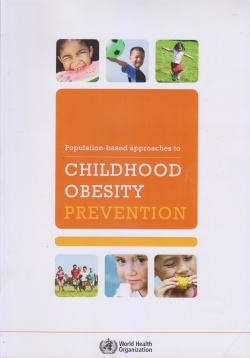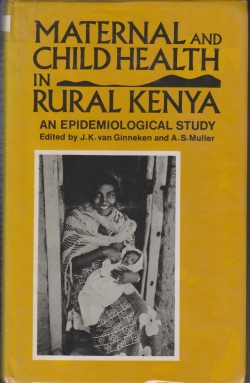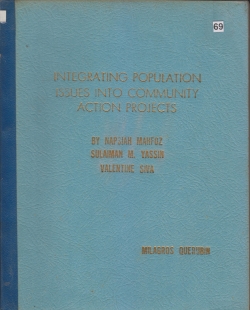Population-based approaches to childhood obesity prevention set of tools Prioritizing areas for action in the field of population-based prevention of childhood obesity : a set of tools for member states to determine and identify priority areas for action

Buy online ($)
Type
Book
Authors
ISBN 13
9789241503273
Category
Publication Year
2012
Publisher
Pages
84
Subject
Obesity--Prevention and control ; Obesity in children
Description
The prevalence of overweight and obesity has increased substantially over the past three decades. Due to this rapid prevalence increase and the associated health consequences, obesity is considered one of the most serious health challenges of the early 21st century. While he need for preventive action is increasingly recognized, policy implementation often occurs in a non-systematic, ad hoc manner. Policy actions are likely to be more cohesive and comprehensive if decision processes are more systematic, evidence-based and stakeholder-informed.
The purpose of this document is to provide a set of tools for Member States to determine and identity priority areas for action in the field of population-based prevention of childhood obesity. The tools presented are intended to facilitate a prioritization process that is both systematic and locally relevant.
A number of approaches exist for setting priority areas for action. The following steps are common to all approaches:
1. Problem identification and needs analysis
2.Identification of potential solutions
3.Assessment and prioritization of potential solutions
4.Strategy devvelopment
Three priority-setting approaches are described in this document: the WHO Stepwise framework for preventing chronic disease, the Modified Problem/ Solution Tree (mPAST) process and the ANGELO (Analysis Grid for Elements Linked to Obesity) process.
While these priority-setting approaches all contain common elements, the contexts in which they are used, the processes they involve, and the technical analyses differ. Selection of the most appropriate tool is dependent on the purpose, desired outcomes and criteria to be used for assessment (for example, population impact or effectiveness, costs, cost-effectiveness, feasibility, relevance, strength of evidence base, effects on equity, sustainability, acceptability to stakeholders), level of resources (including financial, technical expertise and time) and data available.
The WHO Stepwise framework for preventing chronic diseases considers feasibility, impact and affordability, and has been developed for use mainly in low-and-middle-income countries with limited resources and funding. The Modified Problem/Solution Tree process has been used for identifying barriers to action and solutions to overcome them, and uses factors such as relevance, feasibility, acceptability and effectiveness during the priority-setting process. The ANGELO process has been used to develop community action plans, and takes into account importance (which incorporates both relevance and impact) and feasibility as part of the prioritization process. All the approaches apply "due process" by working with stakeholders as an integral pf prioritization, and use the best available evidence to inform decisions. Detailed eplanations of the WHO Stepwise framework for preventing chronic disease, Modified Problem/Solution Tree process and the ANGELO process are given, including examples and samples worksheets.
Throughout the document, it is stressed that, regardless of the tool selected, due consideration must be given to local, regional or country-specific factors when analysing potential areas for action. It is also essential to take into account all relevant sectors and settings in order to identify areas for action in a comprehensive way. Finally, the identification of key stakeholders and the outlining of their potential roles and responsibilities is critical for the prioritization process. Each of the priority-setting approaches will require facilitation expertise to manage the process of working with the relevant stakeholders so that the priority actions to recommend are realized.
Priority-setting to create a set of recommended, promising policy interventions is an essential part of evidence-informed policy-making; however, it is only the beginning of the process. The recommendations need to be accepted by the community leaders or politicians who make the decisions and this usually takes an advocacy effort. Once endorsed, the actions need to be funded and implemented requiring project or programme management skills.
The purpose of this document is to provide a set of tools for Member States to determine and identity priority areas for action in the field of population-based prevention of childhood obesity. The tools presented are intended to facilitate a prioritization process that is both systematic and locally relevant.
A number of approaches exist for setting priority areas for action. The following steps are common to all approaches:
1. Problem identification and needs analysis
2.Identification of potential solutions
3.Assessment and prioritization of potential solutions
4.Strategy devvelopment
Three priority-setting approaches are described in this document: the WHO Stepwise framework for preventing chronic disease, the Modified Problem/ Solution Tree (mPAST) process and the ANGELO (Analysis Grid for Elements Linked to Obesity) process.
While these priority-setting approaches all contain common elements, the contexts in which they are used, the processes they involve, and the technical analyses differ. Selection of the most appropriate tool is dependent on the purpose, desired outcomes and criteria to be used for assessment (for example, population impact or effectiveness, costs, cost-effectiveness, feasibility, relevance, strength of evidence base, effects on equity, sustainability, acceptability to stakeholders), level of resources (including financial, technical expertise and time) and data available.
The WHO Stepwise framework for preventing chronic diseases considers feasibility, impact and affordability, and has been developed for use mainly in low-and-middle-income countries with limited resources and funding. The Modified Problem/Solution Tree process has been used for identifying barriers to action and solutions to overcome them, and uses factors such as relevance, feasibility, acceptability and effectiveness during the priority-setting process. The ANGELO process has been used to develop community action plans, and takes into account importance (which incorporates both relevance and impact) and feasibility as part of the prioritization process. All the approaches apply "due process" by working with stakeholders as an integral pf prioritization, and use the best available evidence to inform decisions. Detailed eplanations of the WHO Stepwise framework for preventing chronic disease, Modified Problem/Solution Tree process and the ANGELO process are given, including examples and samples worksheets.
Throughout the document, it is stressed that, regardless of the tool selected, due consideration must be given to local, regional or country-specific factors when analysing potential areas for action. It is also essential to take into account all relevant sectors and settings in order to identify areas for action in a comprehensive way. Finally, the identification of key stakeholders and the outlining of their potential roles and responsibilities is critical for the prioritization process. Each of the priority-setting approaches will require facilitation expertise to manage the process of working with the relevant stakeholders so that the priority actions to recommend are realized.
Priority-setting to create a set of recommended, promising policy interventions is an essential part of evidence-informed policy-making; however, it is only the beginning of the process. The recommendations need to be accepted by the community leaders or politicians who make the decisions and this usually takes an advocacy effort. Once endorsed, the actions need to be funded and implemented requiring project or programme management skills.
Number of Copies
1
| Library | Accession No | Call No | Copy No | Edition | Location | Availability |
|---|---|---|---|---|---|---|
| Main | 973 | RJ 399 C6 P61 | 1 | Yes |




